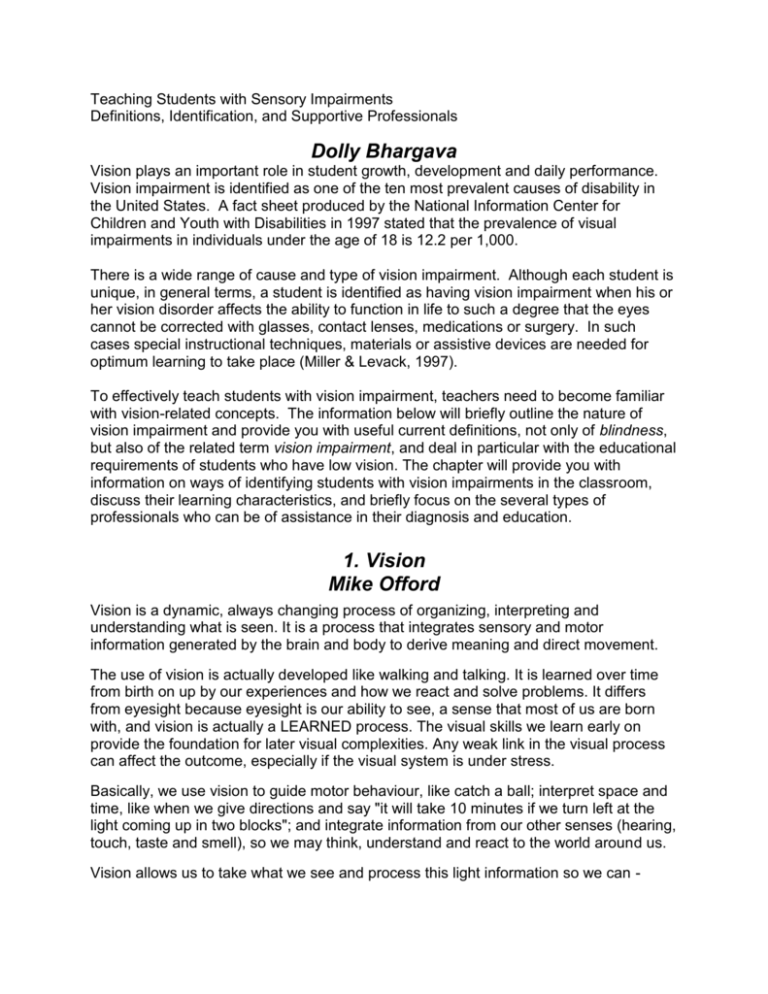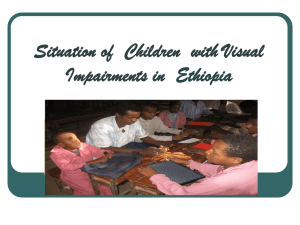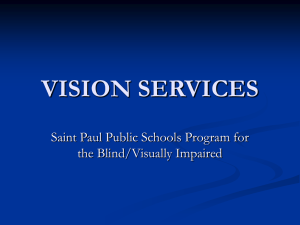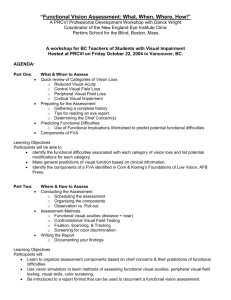Chapter 2
advertisement

Teaching Students with Sensory Impairments Definitions, Identification, and Supportive Professionals Dolly Bhargava Vision plays an important role in student growth, development and daily performance. Vision impairment is identified as one of the ten most prevalent causes of disability in the United States. A fact sheet produced by the National Information Center for Children and Youth with Disabilities in 1997 stated that the prevalence of visual impairments in individuals under the age of 18 is 12.2 per 1,000. There is a wide range of cause and type of vision impairment. Although each student is unique, in general terms, a student is identified as having vision impairment when his or her vision disorder affects the ability to function in life to such a degree that the eyes cannot be corrected with glasses, contact lenses, medications or surgery. In such cases special instructional techniques, materials or assistive devices are needed for optimum learning to take place (Miller & Levack, 1997). To effectively teach students with vision impairment, teachers need to become familiar with vision-related concepts. The information below will briefly outline the nature of vision impairment and provide you with useful current definitions, not only of blindness, but also of the related term vision impairment, and deal in particular with the educational requirements of students who have low vision. The chapter will provide you with information on ways of identifying students with vision impairments in the classroom, discuss their learning characteristics, and briefly focus on the several types of professionals who can be of assistance in their diagnosis and education. 1. Vision Mike Offord Vision is a dynamic, always changing process of organizing, interpreting and understanding what is seen. It is a process that integrates sensory and motor information generated by the brain and body to derive meaning and direct movement. The use of vision is actually developed like walking and talking. It is learned over time from birth on up by our experiences and how we react and solve problems. It differs from eyesight because eyesight is our ability to see, a sense that most of us are born with, and vision is actually a LEARNED process. The visual skills we learn early on provide the foundation for later visual complexities. Any weak link in the visual process can affect the outcome, especially if the visual system is under stress. Basically, we use vision to guide motor behaviour, like catch a ball; interpret space and time, like when we give directions and say "it will take 10 minutes if we turn left at the light coming up in two blocks"; and integrate information from our other senses (hearing, touch, taste and smell), so we may think, understand and react to the world around us. Vision allows us to take what we see and process this light information so we can - Identify what we see by where it is, how far away it is, how big it is, how fast it is moving, what texture it has, etc. Store this current information for future retrieval. Integrate the sight information with all our other senses - touch, hearing, taste and smell. Compare this information to previously stored information in order to confirm prior experience or reconstruct a prior experience if necessary. Derive meaning from both the new information and past information. Decide the relationship between where we are and where it is, or find out where we are in space. Act on this new meaning. Use this new perception to direct movement or thought. 2. Definitions of Vision Impairment Dolly Bhargava A student with a vision impairment is part of a heterogeneous group whose one common characteristic is some degree of vision loss. Vision is a perceptual process with three elements: the eye, the optic pathway and the brain (MacLean, 1998). For vision to occur, all three elements must be functioning. Educationally, there are three major groups of students (or learners) with vision impairments in our schools: 1. Learners who are “educationally blind”: These students have little or no functional vision for learning and primarily use Braille, audio and tactile aids in their learning. 2. Learners with low vision: After correction (i.e., with glasses), these students are able to use vision for learning and are generally dependent on low-vision aids and environmental modifications for assistance; 3. Learners with correctable low vision. These are students who, after correction, can use their vision effectively and without too much extra help (Kelley, Gale & Blatch, 1998, p. 35). These three categories are helpful to you as a teacher as they suggest the teaching and learning frameworks that must be set in place so that each student can properly access the curriculum. A. How is Vision Measured? Dolly Bhargava In two ways: First by measuring a students’ visual acuity and then their field of vision. A-1. Visual Acuity Visual acuity refers to the ability to see sharply and clearly at both short and long distances to distinguish detail and shape. Each eye has its own level of visual acuity and the level of visual acuity of each eye can differ considerably. Visual acuity is usually measured by determining the smallest letter or picture or symbol that a person can read on a standardized eye examination chart. The visual acuity measurement is expressed as a fraction. Normal vision is defined as a person having 20/20 or 6/6 visual acuity. The numerator (top number) refers to the distance a person stands from the eye examination chart. In the United States this number generally represents a distance of about 20 feet. In countries where meters are used, the distance is 6 meters long, approximately 20 feet. The denominator (bottom number) indicates the smallest letter, number or symbol that the person can read. The lower the bottom number in the visual acuity ratio, the better the acuity. The greater the bottom number, the worse the acuity. For example, 20/100 is a better visual acuity than 20/200 acuity. Examples of what a person with different visual acuities may see for distance vision Mike Offord. Examples of what a person with different visual acuities may see at an eye chart at 6 metres Mike Offord. Approximations of Vision with Different Acuities – Distance Vision Approximations of Vision with Different Acuities – Eye Chart at 6 metres A - 2. Field of Vision Field of Vision refers to the area within the environment that a person can see when looking straight ahead. If the field of vision is restricted then the person will miss seeing some parts of the whole scene or image (Orlansky, 1977). The normal field of vision of is 180 degrees. Certain measures of visual acuity and field of vision have special significance in terms of diagnosing vision impairments. We will use these measurements to describe two types of vision impairment that are commonly used in the educational context: (a) low vision, and (b) legal blindness. It is important to note that definitions of these terms may vary. However, for the purposes of this handbook they are as follows: A-3. Legal Blindness Students who are legally blind As an eligibility criterion for government assistance, a legal definition of blindness is used. In the USA, to be considered legally blind, an individual's visual acuity must be equal to or less than 20/200 with the best possible correction, or a visual field of 10 degrees or less. Someone with a visual acuity of 20/200 can see at 20 feet what someone without a vision impairment can see at 200 feet. In countries where a metric system is used a student is considered "legally blind" when his/her visual acuity is 6/60 What a person without vision impairment vision would see at 60 meters is what the student who is legally blind sees at 6 meters or less in the better eye, even with correction. A person who is legally blind has a field of view which is 10 degrees or less in the better eye (Kelley & Gale, 1998). Blindness cannot be corrected by medical or surgical means or corrective eye wear. The student needs instruction that emphasizes the use of his or her other senses, for example, touch (i.e., Braille) and hearing (i.e., auditory tapes) to learn about the world and complete tasks (Orlansky, 1977; Lewis & Allman, 2000). A-4. Low Vision Students who have Low Vision The definition of low vision for most legal purposes in the United State is a visual acuity between 20/70 and 20/200 with correction in the best eye, or a field of vision less than 20 degrees, compared to normal field of vision of 180 degrees. In countries using a metric system low vision is denoted by a student having a visual acuity of less than 6/18 (what a person with normal vision would see at 18 meters is what the student with low vision sees at 6 meters) or less or if his/her field of view is 20 degrees or less (Best & Corn, 1993 cited in Kelley & Gale, 1998). Low vision is not the same as blindness, as the person with low vision has some sight, yet has difficulty accomplishing visual tasks using sight. “A student who has low vision can enhance his or her ability to accomplish tasks with the use of compensatory visual strategies, low vision devices, and environmental modifications” (Corn & Koenig, 1996, p.4). This process includes the provision of visual strategies ( i.e., enlarged print); specialized optical devices ( i.e., magnifiers or telescopes); non-optical devices ( i.e., bold line black markers) and environmental modifications ( i.e., changing seating position in class) (Lewis & Allman, 2000). When determining the needs and abilities of a student with vision impairment it is important to look beyond the label e.g. ‘low vision’ or a numerical value e.g. 20/200. Instead we need to appreciate the fact that there is no “typical” student with vision impairment. The impact of the vision impairment on a student will depend upon on the following factors: - type of eye condition - age of onset - degree of functional vision - visual efficiency - type of intervention provided To help explain this, let’s consider one of these factors. The age of onset of vision impairment has different effects on the child’s communication and cognitive development. Consider the cases of Joanne and Rita, both of whom are six years of age and have a vision impairment. Joanne was born blind, whereas Rita was born with normal vision but became blind at the age of three as a result of a car accident. One of the areas of development effected by vision impairment is the development of self help skills. Self-help includes self-routines such as eating, dressing, toileting and grooming. Many of these self-help skills are usually learned through observation. There are qualitative differences between the self-help abilities of Rita and Joanne. For example, Rita who became adventitiously blind had the opportunity to see different types of foods, eating utensils, mealtime locations and seen others eat. Whereas, Joanne who was congenitally blind had never had sight required specific guidance and a variety of experiences in order to understand concepts related to eating. Therefore, every student with vision impairment has unique needs and abilities. Understanding the background history will determine unique educational support needs and determine the best type of assistance (Anderson, 2003).







